News
The following is a journal that will include general construction news regarding the virtual railway project that I hope to update whenever there is sectional progress or something of interest to report. I wish that I had started earlier because it has been quite an interesting journey to date, however there is still a long way to go so better late than never.
Prior to the publishing of these web pages in January 2019 the project had been completed, along with a the few available videos, from Lindsay to Beaverton. Since that time I have been slowly working my way toward Orillia while constructing new models of structures and locomotives along the way.
The "Pic-Of-The-Week" is from my railway photography collection of 35mm Ektachrome and Kodachrome color slide film taken in the early-1990s that will add a regular update to this page. The vast majority of pics were taken in central, northern, and eastern regions of the Province of Ontario, Canada.
Pic-Of-The-Week
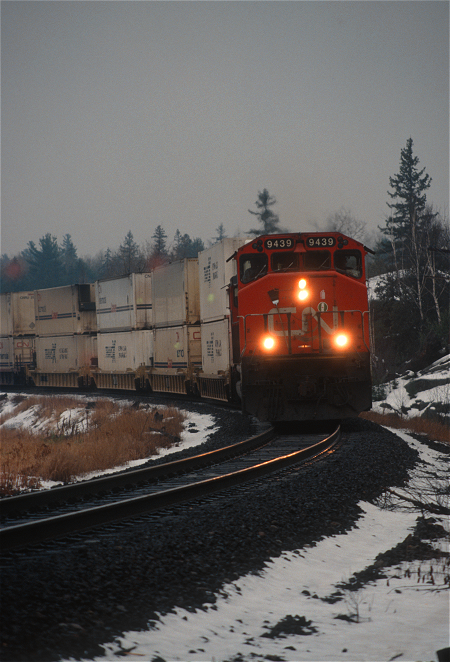
Double stack attack! - Photo by Author
Apr 16, 2020
Making progress towards Orillia
It has been a very long time between updates this time around but I'm finally back with some news regarding the goings on over the last four months.
Beginning with December of last year, I did manage another trip to the National Archives in Ottawa to look at some additional material that they had made available for me. I was able to look through and record a few of the late-stock register books from the George Cox-era. Not surprisingly, after the Hugel-presidency dust had settled, Uthoff & Company as well as Cox himself, held the most shares leaving Mr. Hugel with only 11 shares total. Uthoff and Company may have been underwriting the unsold shares. The former partners in this company, Messrs. Fesser and Uthoff, had towns along the right-of-way named after them during the Hugel presidency. It seems as though the vast majority of smaller investments were made by folks in the United Kingdom, while the larger shareholders, not bondholders, were in Canada. Later into the Cox-presidency, some of the most notable shareholders, as far as volume was concerned, were Don McInnes and John Proctor of Hamilton, George Laidlaw, and John McDougall & Company (manufacturers and financiers). Much smaller, however still substantial, investors included the Hon. John Beverly, C.W. Bunting; R.W. Elliot; W.W. Copp; R.H. Ramsay; H.P. Dwight; John Shedden(T&N); George Stephen(CPR); and W.C. Fitch.
In the new year I began work on a new website which will showcase, in online galleries, my collection of railroad photography from the early-1990s. Organizing and scanning the collection is something that I really needed to get underway, as the transparencies will progressively fade in colour along with my memory of the locations where I photographed them. I have the basic website complete with about 1/4 of the collection scanned and processed to date. The plan is to continue the project along with the 3d model railway project simultaneously until they are both complete. Of course, that will take years, so in the meantime I am sending out links to the handful of enthusiasts who are interested in viewing the currently available images.
And regarding the virtual model railway, I am finally getting back to work on that project after it had been sidelined for a few months. In fits and starts I have been building an animated Ice Factory for the landscape between The Narrows at Atherley and the town of Orillia, Ontario, and I'm pleased to say that that model is now complete. I had wondered whether or not I should go bother animating a factory that was only in operation during the winter season when this model is not, but decided to take that liberty and have ice blocks magically appear out of the warm fall waters of Pumpkin Bay. I did however compose a generic wintery scene with the factory in operation in order to make a quick video recording for this update:
It's now time to finally begin laying the track into Orillia and constructing the incredible station that once existed on the Midland Railway line in that town, and I hope to making updates to this page more frequently in future.
Nov 24, 2019
Finally crossing Atherley Narrows
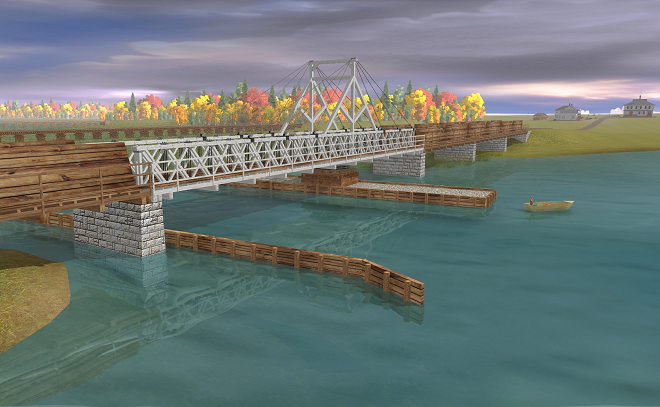
The road bridge at The Narrows w/Atherley hotels in background. (even back then the fishermen counldn't keep out of the channels!)
I have been so busy with life's other priorities over the last month or two that the project had to be ignored for all but a few evening hours during the weekdays. I have however been making a push in recent days allotting many hours in hopes of completing a few tasks before the new year.
As things currently stand I have now completed and placed the three swing bridges at The Narrows and the track is now in place. I have utilized bits and pieces for the Lindsay bridges, but rest assured they are all unique structures. However, in general, these swing bridges were all of similar design. As is obvious when looking at the photos, when in the open position additional support was provided by cables on center posts or towers over a center crib at the bottom or the water filled with stone. I imagine I will still be working in the area for a few more days at least, but certainly hope to be at this sections terminus, Orillia, before the new year.
Oct 11, 2019
Bridges at Atherley Narrows
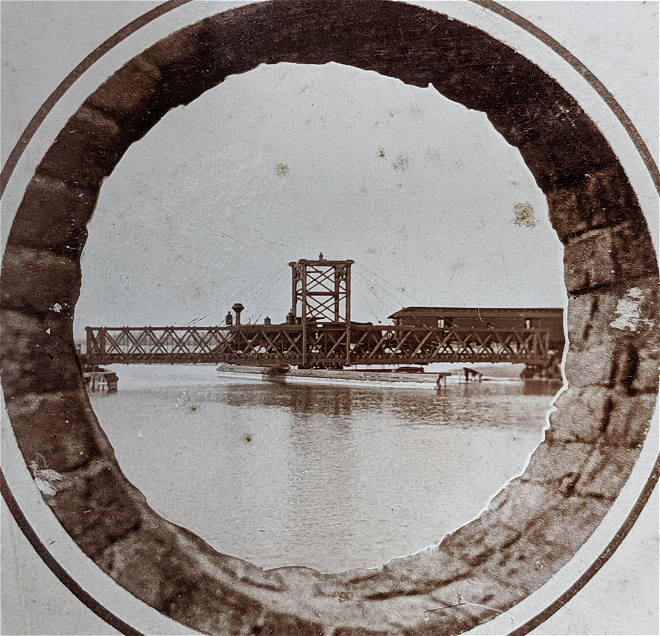
Midland Railway Bridge, Atherley Narrows - J.E. Curran, Library and Archives Canada PA-143087
The main purpose of my recent trip to the National Archives was to gather some photographic evidence regarding the construction design of the early bridges at the narrows between Lakes Simcoe and Couchiching. The vast majority of the early-wooden road/rail swing bridges were of the Howe-truss variety that are supported by cables tensioned over a central tower for support when the bridge was not resting on abutments in the closed position. Therefore, although the design could vary to some degree, it was doubtful that any enlightening new information would be forthcoming.
It seems that these types of timber bridges had a lifespan of between 12-15 years before a complete overhaul or an all out replacement was necessary, and as such, there may have been numerous timber railway swing bridges constructed at "The Narrows" between 1871 and 1904 when the first iron girder bridge was installed by the Grand Truck Railway.
Of the timber bridges, there are photographs of two different structures on the old Midland right-of-way. The first image looks to have been taken by an original Kodak 1 box camera produced between 1889 and 1895. Although the image is tightly cropped with what looks to be a shutter malfunction (or horrible looking border effect), it was probably taken from the new road bridge that is 375ft to the south of the Midland bridge. Even if taken in the first year of the cameras production, 1889, it is likely that the old Northern bridge would have already been removed by the Grand Trunk as the Midland and Northern lines were consolidated between Orillia and Atherley after 1887. When I first viewed the image I immediately believed it to be of the old Northern bridge because of what looks to be the silhouette of a Kingston locomotive on the bridge, but upon further investigation it became doubtful because a) the camera make and model; b) the 740ft distance from the Northern bridge and the Midland right-of-way - presumable where the photo would have been taken from if not taken from a boat; and c) the post-1887 consolidation of the lines in the area would require ex-Northern locomotives to run over the former Midland bridge.
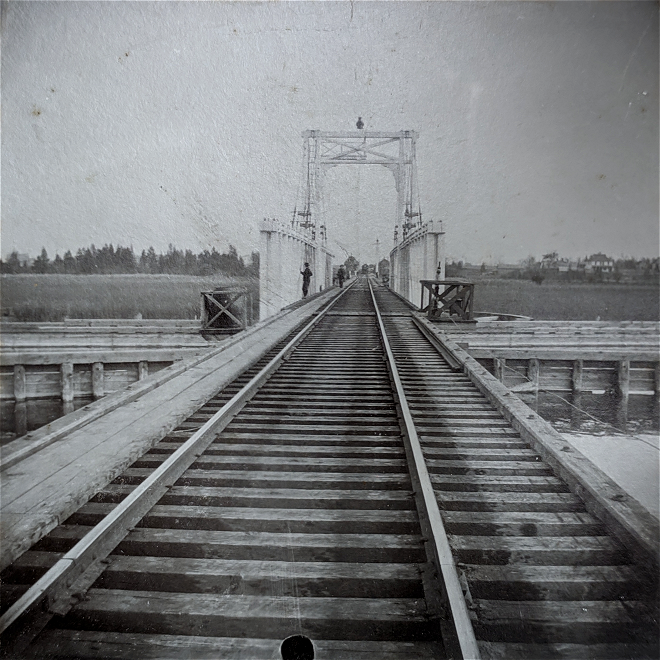
Midland Railway Bridge built in 1896, Atherley Narrows - J.E. Curran, Library and Archives Canada PA-143082
The chief engineer of the Midland Railway at the time of initial rail bridge construction, Mr. Stewart, had stated that the companies original bridge over The Narrows was of a better design than that of the Northern bridge. However, besides the obvious benefits of the location, I can't imagine the swing section being too much better in design than that of the Northern. The Midland bridge has a central square tower whereas the Northern may have been a kingpost or a-frame center design. The Northern had also built stone abutments that look to be still visible on the east-side of the turret today.
In 1896 the G.T.R replaced the old Midland bridge with a new cable-stayed Howe Truss with an a-frame central support design. A few photographs of this structure were taken after construction including the one shown here. Notice the Myer's store at Atherley to the right that would become the contemporary, and currently abandoned, Atherley Arms Hotel.
Mr. Stewart also declared the road swing bridge to the south of the railway bridge to be that of the "common type", presumably meaning of timber kingpost design. The no doubt numerous timber road bridges built at The Narrows were replaced by the first iron bridge in the late-1880s.
The photograph I had much anticipated seeing prior to my visit was captioned "The Old Northern Bridge", which, alas, turned out to be a ca. 1898 image of the rotting cribwork and stone abutment. It sounds like the bridge was not in great shape prior to the Grand Trunk takeover late in 1887, and with the much more favourable Grand Trunk Midland crossing to the south, the Northern structure was probably removed within the next year.
Hopefully more drawings or photographs will become available, but as mentioned, it is unlikely that any of the original bridges differed from the common Howe Truss design. Therefore, the model of the Midland wil be as is in the older photograph, and the Northern bridge much the same but with a slightly different center tower and stone abutments.
Midland Ry. Engine Under Steam in Orillia!
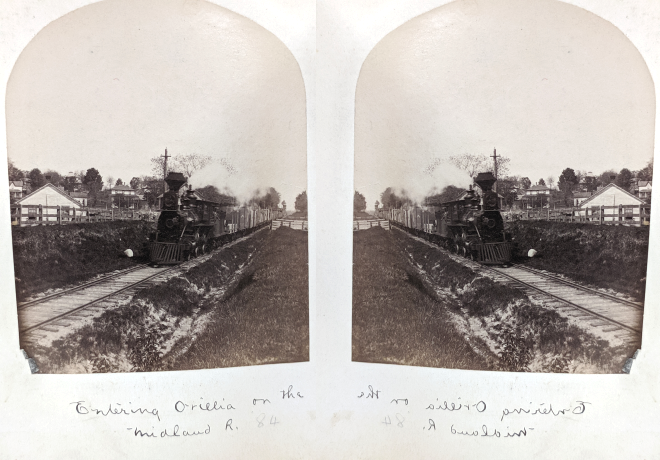
Train leaving Orillia for Midland ca. 1895 - J.E. Curran, Library and Archives Canada
I don't recall ever seeing a photograph of a Portland-built Midland Railway of Canada engine "under steam" in my research travels, and certainly nothing like it between Orillia and Midland. This interesting photograph is exactly what you would have witnessed anytime after initial construction of the line to around the turn of the 20th-century. It is, however, most probable that the train was running on the Midland Division of the Grand Trunk Railway (at the time the photograph was taken), and not the Midland Railway of Canada pre-1894, despite the locomotive dating back to the 1870s.
Although the terrain behind the train places it at the north end of town, I had a heck of a time placing it's exact location along the right-of-way. With the image captioned "Entering Orillia on the Midland Ry.", it should have been quite easy provided one or two of the houses had survived. I was reasonably sure about one of the houses, but it did not line up with the track as it does in the photograph. A second house with a mansard roof sits behind a tree overlooking the scene, but I could not locate it in that area of town as it had since be torn down and replaced with another. When I turned to the libraries online digital collection of photographs to see if a image of the unique home happened to exist, I lucked out and found one complete with an address. The only problem was, the location of the home still did not line up with the right-of-way! At this point I was about to start pulling out my hair when... bingo, I reversed the photograph and all was right with the right-of-way in the town of Orillia. The photograph was taken between Borland and Cedar streets as the train was "Leaving" Orillia on the Midland/GTR Ry.
Of course, in hindsight, obvious clues appeared such as the empty cars and dark shadow on the front end of the locomotive heading north. If the front end had not been blacked out by shadow the engine number would have been visible and the original developer of the print, or at least I, would have been tipped off immediately.
Model Progress
I have just about completed three models of hotels and the old mill at Atherley. I still have a lot of work to do in the area but hope to be crossing The Narrows in the not-too-distant-future.
Sept 12, 2019
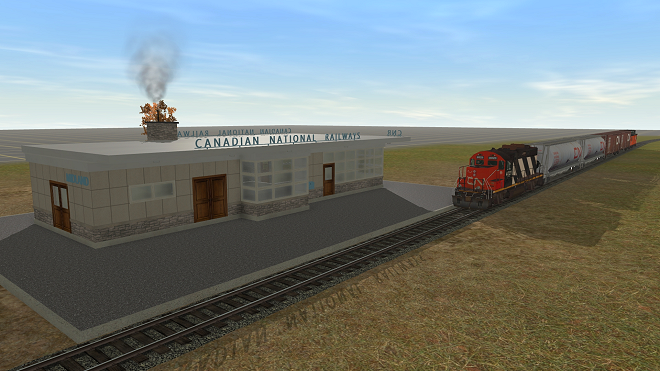
The Canadian National Railway's station in Midland, Ontario. d.1947-1997
Winding down summertime with a recent short trip out to Eastern Ontario, and now looking forward to the upcoming colours of fall. A side-project diversion today with a much more modern model than the Victorian-era structures I have been creating for this project over the past few years. This recently completed model is of the Canadian National Railway's Midland, Ontario station that was completed by the company in 1947. By the time I came onto the scene in the early-90s the building was boarded up, however I did make an open interior that can be updated when and if I happen to run into the layout. I'm also not sure if this was a one-off structure, but would be happy to make a generic version, or possibly even alter the name on the side upon request. Although constructed with multiple levels-of-detail, I believe that this particular model tips the maximum allowed mesh scale limit that is necessary for uploading to the online Trainz Download Station. Therefore, I will add a link below for downloading.
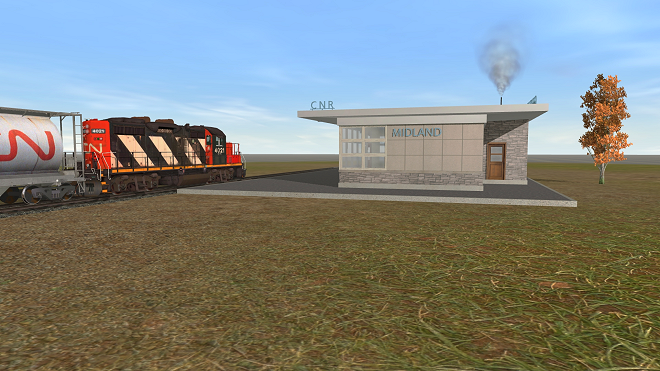
The locomotive and cars, created by other modelers, are excellent replicas and fit the late-era seen.
A unique component of this particular station was the incorporation of a single stone, as part of the masonry, from the ruins of the old French mission to the Huron Indians, Ste. Marie. The fort was constructed back in the early 17th century on the banks of the Wye River at what was the western limits of the French frontier in Canada, and for that matter North America. The reconstruction of the fort sits at the same location as the railway bridge that crosses the Wye River. The fort was abandoned during an Iroquois invasion into the region (now known as Huronia), which was part of a much larger drive north and west through much of the Ojibwa nations lands. The area was retaken by the Ojibwa a half-century later, however the Huron, an Iroquois people themselves, had been dispersed from the area forever. There is what looks like a datestone on the back of the station structure which eludes to this, however I'm not sure exactly what was engraved on it. Maybe my next trip to the museum will enlighten me. Huronia is roughly the area between Midland, Orillia, and Barrie, Ontario.
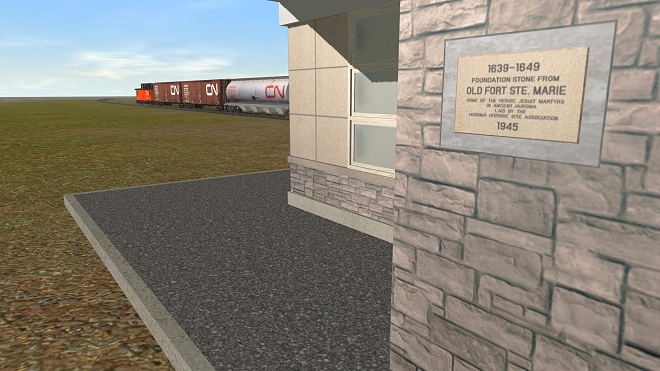
The datestone and engraving.
You can download the Trainz version of the model here: CNR Station Midland
(Import the CDP file into the game using the content manager.)
Update: Thanks to Chris Furman, no sooner had I mentioned the need to varify what was written on the datestone than the image was readily availble. Both the images herein and CDP file have now been updated.
Regarding the Victorian-era project, I have been researching the hamlet of Atherley and have begun construction on a few of the stores/hotels in the area, as well as setting up the roads and track in and around the place. A modified version of the Atherley Arms hotel still stands to this day at the four corners. I also hope to model the old mill on the lake.
I have also been planning a trip to the National Archives that is set to take place in the coming weeks, hopefully when the leaves have begun to change colour. To date I have yet to come across any visual material regarding the construction of the original Northern Bridge over the narrows.
Aug 18, 2019
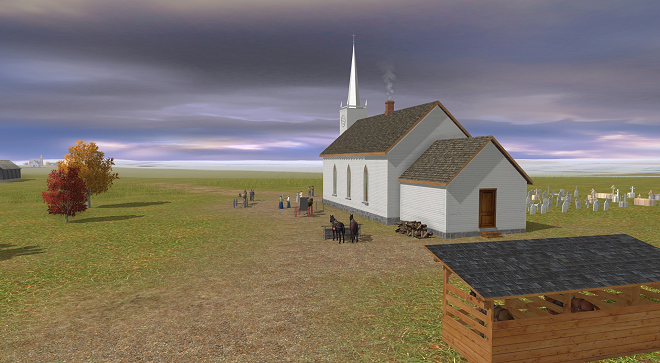
The original St. Columbkille's Church in Uptergrove
Another glorious Sunday morning has evolved and it's time for another update from my never ending project. What's been going on lately is the tracks have finally emerged from the swampland and constructed into the more pleasant terrain surrounding the hamlet of Uptergrove - which is not too far from Atherley and Orillia--thank goodness! The two mainstays of the community are the churches, St. Columbkille and Knox Presbyterian. Both have been around prior to the arrival of the railway and of course have their own unique features as all churches seem to. The original St. Columbkille has long been replaced by the grand structure you see today, however I was able to locate a grainy photograph of the original structure at the local library which was enough for me to surmise how it was constructed. The Knox structure is still standing with modifications but again I was able to locate a picture of the version reconstructed in 1883 which also happens to be the circa of the model.
St. Columbkille is located approximately 1 kilometer (as the crow flies) from the village of Uptergrove, and therefore is not likely to appear on the next video. I am therefore posting a screenshot in hopes that it will be something of interest to some.
The view looks westward with Uptergrove to the far left and the vast white nothingness beyond being the enormous area that remains unfinished.
New to the website are a number of interesting pics of the track removal along the Midland route in Orillia sent in by Chris Furman. See the Modern Day Pics along the ex. Midland and Northern lines in Huronia page for details.
July 21, 2019
Making good progress north of Brechin being almost complete to Uptergrove where I will be modeling a few structures. The area in general is not too exciting with mostly swamp and patches of farmland here and there and many culverts. Today the area is somewhat more interesting with the Lagoon City complex on the west side of the old railbed. As for models I have created a animated flag that I hope to use on some of the locomotives. All in all I'm happy with the recent progress considering it's the middle of summer and water and roads are calling.
I'm still in the process of scanning/rescanning my entire collection of slide film with a plan in mind to create a new website, or atleast an addition to this one, at some point in time. I wasn't as organized back in the day and my collection is all messed up in those old yellow Kodak containers. I probably didn't realized that the day would come where I would have difficulty remembering where I took some of the pics. I spent hours scouring google maps trying trying to match the location of one pic to the point where I was looking on alternative rail lines. As it turned out the crossing and nearby house had been removed when the highway was reconstructed north of Huntsville. Something I would like to do is create contemporary versions of some of the more print worthy images at the thirty year past point in time - even those on some of the abandoned right-of-ways.
June 2, 2019

The original St. Andrew's Church in Brechin
Another fine, however cool, Sunday morning to start June off. I've been messin' around the Brechin area trying to finish up the section to an acceptable degree before moving north along the corridor.
The map corridor is approximately 3 miles/5km wide and as such includes the village of Brechin. Although a few miles from the railbed, I wanted to model something from there as it was back in the day. The prominent architectural structure in the village was, and still is, St. Andrew's Catholic Church. I found a few fuzzy images of the original structure and reconstructed all of the finicky details as close to what I could make out as possible. There seem to be many images from the village but none dating back to the 19th century, and therefore all observable structures besides the church are second generation. I did see a early twentieth century pic of a diminutive barber shop at the four corners that looked to be of earlier vintage so I made a quick likeness of that structure as well.
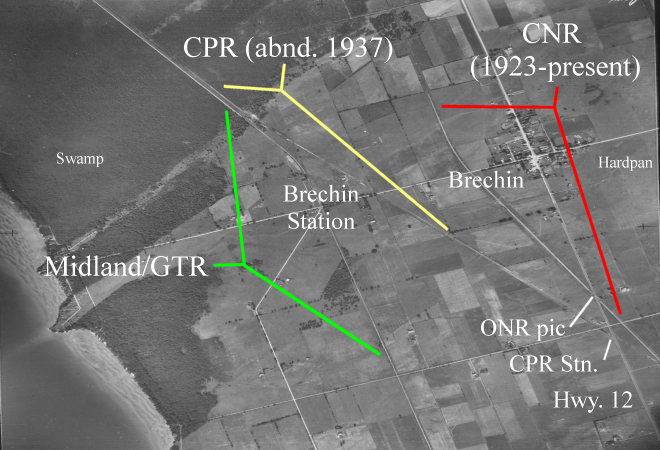
Enery, Mines and Resources Canada via Trent University
Brechin Station sat midway between the lake and the town and an attempt was made to create a hamlet around it with what looks like forty acres of land divided into lots. A Methodist church was constructed on the opposite side of the tracks, but when nothing seemed to come of the whole enterprise it was moved into Brechin proper in 1888.
Besides the Midland, the initial railway built in the 1870s, two other railway lines were constructed through the area after the turn of the century - the Canadian Northern to Parry Sound and the Canadian Pacific to Port McNicoll. The CPR, short lived as it was, followed the same general route from Lindsay to Georgian Bay as the Midland and would parallel it directly for the five miles north of Brechin Station to Uptergrove, as well as a stretch northwest of Orillia. The Canadian Northern's line, now apart of the Canadian National's Bala Subdivision, runs through Brechin and crosses Highway 12 three times north of Beaverton - an annoyance to motorists--especially during busy cottage traffic days.
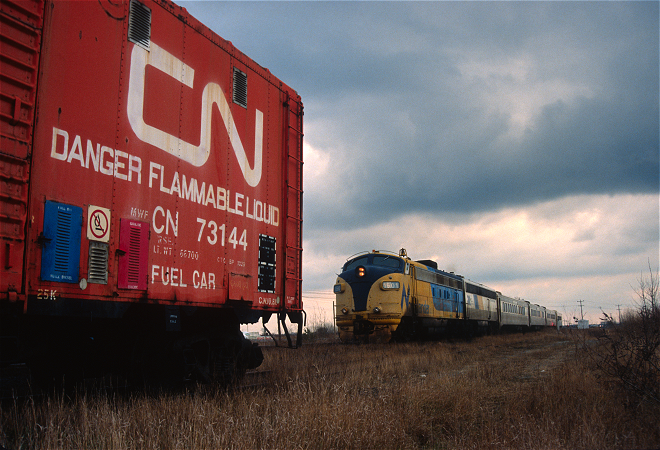
Ontario Northland's "Northlander" crossing Highway 12 in Brechin on the CNR's Bala Subdivision - Photo by Author @ Ml71.7 Bala
Today the old Midland line is hardly noticeable other than a small bench that marks the location where the line crossed Simcoe St. The old CPR station is now a restaurant on Highway 12 just south of Brechin, and the CNR has a major siding that stretches almost two miles from Brechin to the next crossing of the highway.
When I was photographing the local railways this was never a goto hotspot of mine but I do have a few pics from the area. I'm beginning the process of scanning my entire 35mm slide collection and hope to locate the exact location of all of the images, which number in the hundreds, from Simcoe County, Muskoka, Parry Sound, Haliburton, Ottawa Valley etc. - all taken in the early-1990s. I'm going to add a pic-of-the-week to this blog on what I hope is a weekly basis as time between these posting could span a month or two depending on how busy I am.
Currently the plan with the model is to continue working in this area for a while before moving north to the next section. I have the engineers profile for the area which makes it possible to lay the track pretty much as it was back in the day. A cut and fill technique was used to minimize expenses but did not always work to plan, so I have a premium bottle of Scotch ready for the inspecting engineer...
May 12, 2019
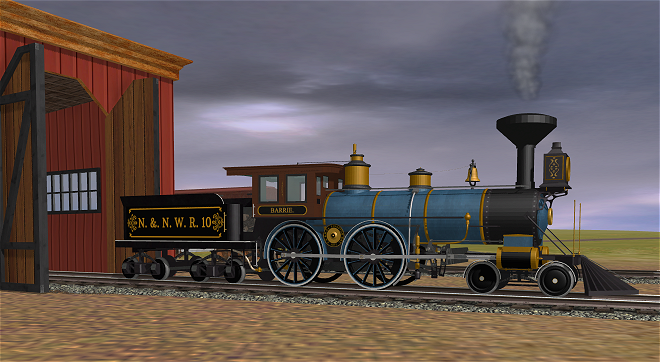
N&NW Engine #10 Barrie fresh out of the shop
Good Sunday morning to all, I have been juggling a home renovation as well as all of lifes other regular duties so I can't say that I have been making great progress, however I usually get in an hour or so each day to keep the project rolling along. I just completed three new additions to the steam engine stable for interactions with the Northern & North Western Railway in Orillia. As previously mentioned the engines are similar to the contemporary Portland-built 4-4-0 models with the same size driving wheels and cylinders so I was able to use that previously built model as a template which sped things up considerably.
Noticeable differences are the cylinders, bell, lamp mount, builders plate, and balance on the driving wheels, but most components were edited to match the Kingston-built machines.
Besides the Barrie, an identical Collingwood with different livery and Halton with balloon stack are the other additions.
April 28, 2019
Within the past few weeks I have moved past Gamebridge Station and into the general vicinity of the town of Brechin, Ontario. The previous section north of Beaverton is quite scenic with views of Lake Simcoe and the crossing of the Talbot River. Conversely, there is nothing too exciting around the Brechin area as far as scenery goes, and it only gets worse north of the station where the next section runs along a five mile straightaway through the swampland enroute to Uptergrove. Looking ahead to the next video I may transfer across the lake to a section of the N&NW Railway for a few minutes while this section is transversed.
To break up the monotony of in-game scenery construction I will always have a 3d model project on the go. The first model constructed north of Beaverton was a log boom for loading timber onto cars at the Talbot River. As with many of the models I will be able to use it again at other locations. Next was a quick rendition of the Royal Oak Hotel in Gamebridge, which is really too far from the track to be worth the effort. I then made models of a standard design Victorian, Ontario, schoolhouse and church which are very similar in design and were lacking in the model until now. Back in the day school sections were eight miles apart meaning some unlucky students would have to walk four miles to and from school everyday. This week I completed the station at Brechin which is of a very unique design. Unfortunately there was an addition added soon after construction that takes away from the overall beauty of the structure.
As for rolling stock, I have completed the locomotive that will power the train in the next video between Beaverton and Atherley or Orillia. I'm very pleased with the look as it is quite different from the Portland-built locos. I'll keep the make and model a secret but it was built overseas. Although very similar to the Portland-built locomotives, I will soon begin construction of a few Kingston-built locomotives for the N&NW which also ran through Orillia and Atherley. I found a few pics in Charles Cooper's "Hamilton's Other Railway" that will be of great help.
Oh, and I added a new "News" section to the website, don't forget to check that out!
Copyright © Stephen M. Farrell 2019 All Rights Reserved
Some of the text, images and videos on this website are not public domain, please contact me for permission to use material on this website.